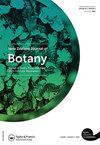分层和遮荫对山楂种子萌发的影响Oerst种子
IF 1.4
4区 生物学
Q4 PLANT SCIENCES
引用次数: 0
摘要
本文章由计算机程序翻译,如有差异,请以英文原文为准。
The effect of stratification and shade on germination of Nothofagus cliffortioides (Hook.f.) Oerst seeds
ABSTRACT Seed stratification can substantially improve germinability. In glasshouse settings, knowledge of stratification requirements is critical for allowing effective control of germination. In addition, for species that seed irregularly, understanding how to break dormancy of aged seeds is important. This study tests whether moisture is required as well as cold conditions to stratify Nothofagus cliffortioides (Hook.f.) Oerst. (mountain beech) seeds, and whether shading during the germination period improves germination and survival. The seeds tested had been collected during a heavy mast year and stored dry for c. 2 years at −20°C. Dry cold stratification failed to break dormancy, with average germination (3.3%) not significantly different from unstratified controls (5.3%). In contrast, average germination of moist cold stratified seeds was at least four times higher (21.7%), with most germination occurring within 30 days. Hessian covers on trays had no impact on germination or survival. These results provide useful information for growing N. cliffortioides from seed and raise the possibility that lengthened drought periods under future climate regimes could affect natural Nothofagus regeneration by reducing the effectiveness of natural winter conditions for breaking seed dormancy.
求助全文
通过发布文献求助,成功后即可免费获取论文全文。
去求助
来源期刊

New Zealand Journal of Botany
生物-植物科学
CiteScore
2.20
自引率
22.20%
发文量
27
审稿时长
>12 weeks
期刊介绍:
The New Zealand Journal of Botany publishes original research papers, review papers, perspectives, short communications, forum articles, letter and book reviews. We welcome submissions relevant to all aspects of the botany, mycology, and phycology of the South Pacific, Australia, South America, and Southern Africa. The journal’s subject matter encompasses biosystematics and biogeography, ecology, physiology, biochemistry, genetics, reproductive biology, structure and development, taxonomy, ethnobotany, palaeobotany, bryology, lichenology, mycology, plant pathology, and phycology.
 求助内容:
求助内容: 应助结果提醒方式:
应助结果提醒方式:


